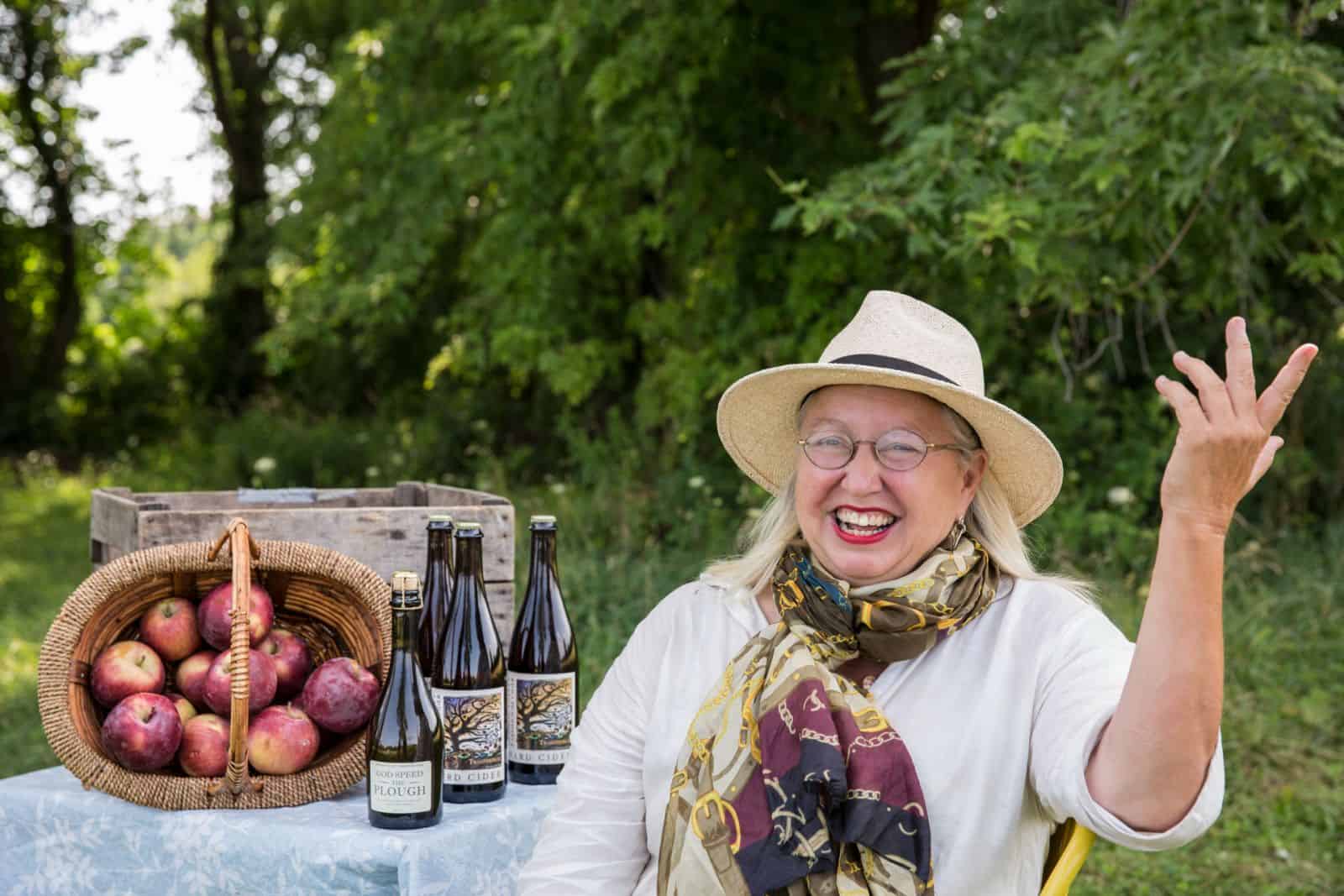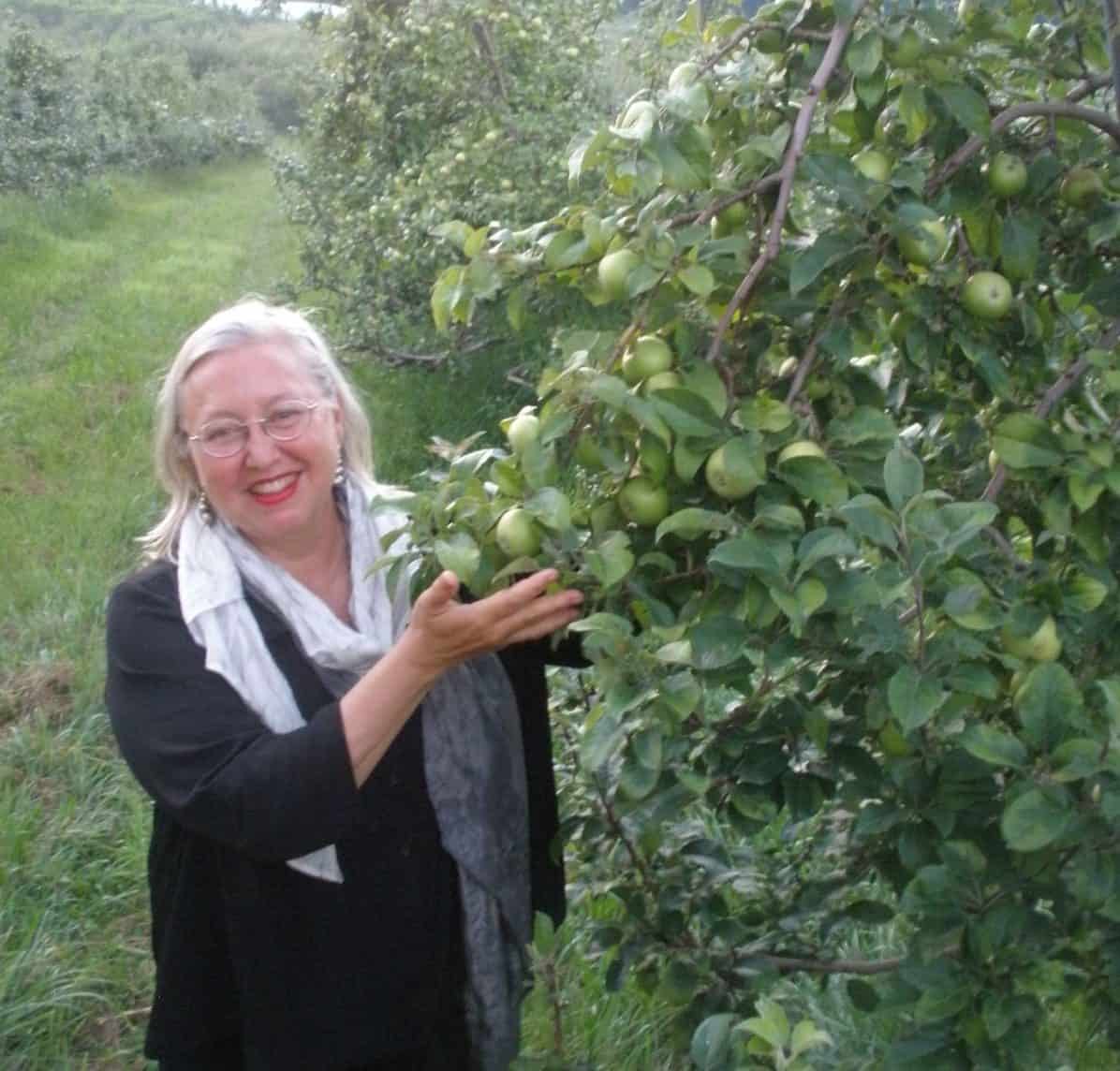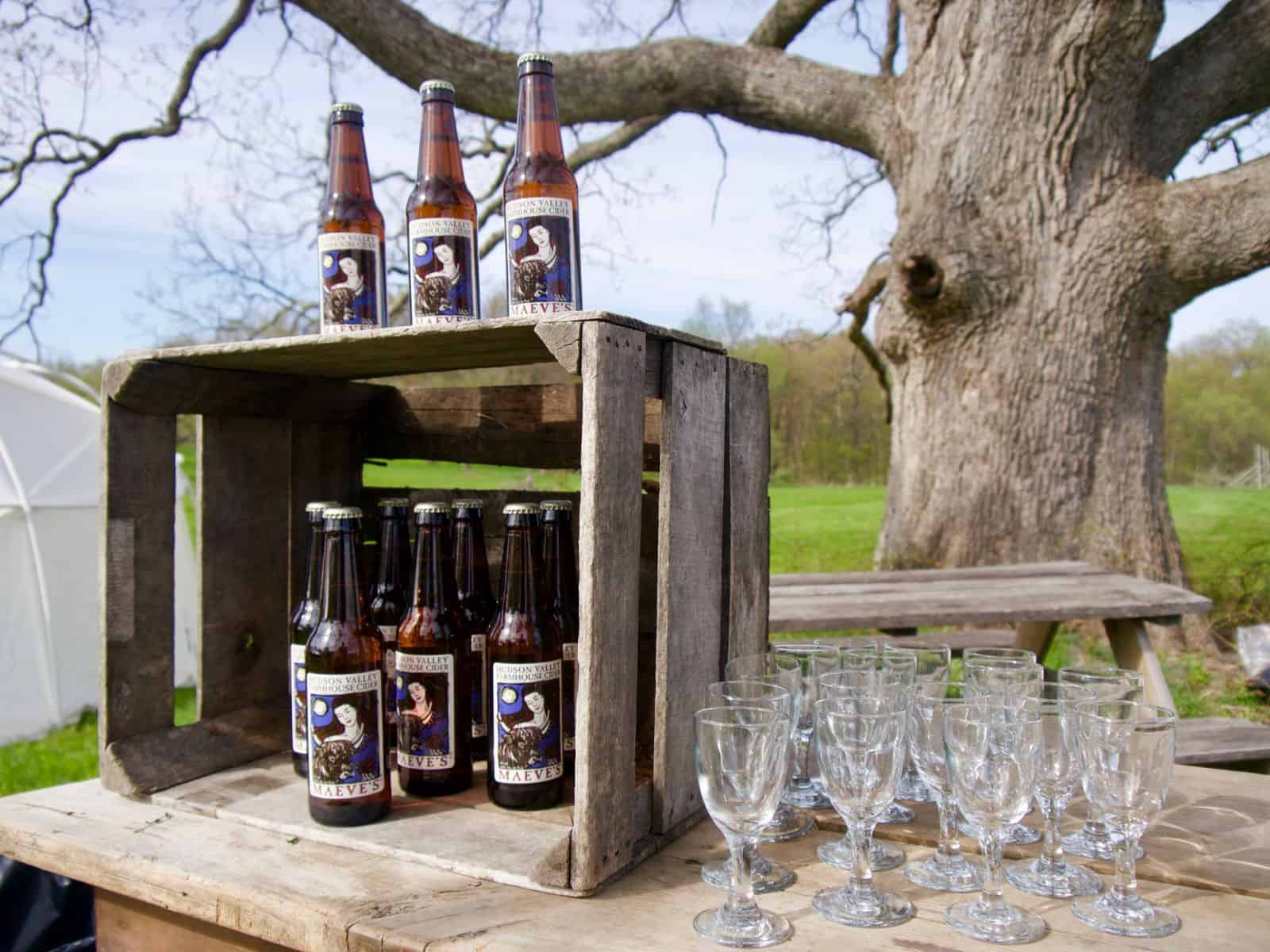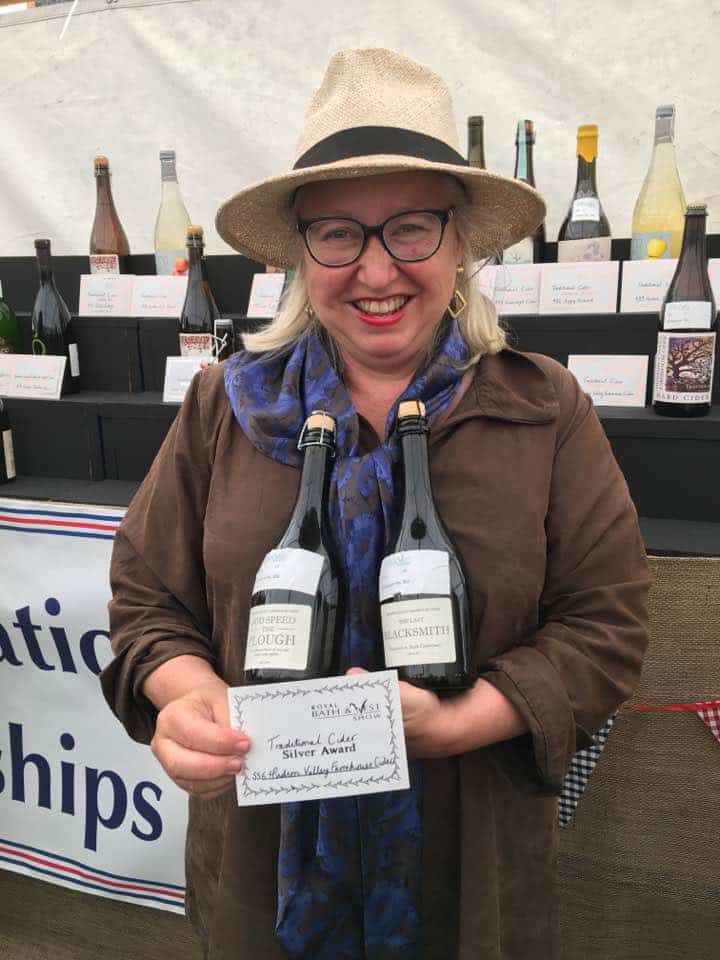Malaika Tyson is one half of the blogging duo Cider Soms, which was started as a way to introduce wine-lovers to the world of cider. Created along with her husband Sean, the “Soms” blog seeks to uncover and explain the complexities of ciders in a fun way.
For Women’s History Month, I want to highlight some of the amazing women cidermakers and cidery owners I’ve met throughout the years. In this Q&A, I speak with Elizabeth Ryan Hudson of Hudson Valley Farmhouse Cider, who goes way, way back in the industry. In fact, she’s been in business for 25 years! So much has changed over those decades, and to speak with her is to dive into the fascinating history of the US cider community, from its nascent stages to the present day.
(The questions and answers have been edited for brevity and clarity.)

Elizabeth Ryan, founder/owner of Hudson Valley Farmhouse Cider
Malaika Tyson: You are one of the first commercial cidermakers of this generation in the US. I can only think of a few women who started making cider when you did. How did you get your start?
Elizabeth Ryan: I made my first barrel of cider in 1980 when I was a student at Cornell University, with apples from the University’s orchards. I have a degree in pomology and I was always interested in cider, which was a de facto non-existent beverage in the 80s. Even though I had taken winemaking classes, there was nothing about making cider. Cider had all but disappeared from the scene, except, maybe once in a while, you’d run into a bottle of French cider. One of the reasons for this is that there were a whole set of laws that inhibited the production of cider in New York and nationally.
I eventually went to work as vineyard manager at Benmarl Winery. Later, I bought an orchard on my own and my then-boyfriend said to me, “I’ll have nothing to do with it.” When he said I had to choose between the orchard and him, I chose the orchard. Eventually he did come around, and we got married, had a kid and eventually divorced. That first orchard (Editor’s note: Elizabeth now runs five farms) had a great array of what I call classic New England cider apples, like Baldwins, Russets, Gravensteins and York Imperials.
All that time, I was one of the few woman apple growers, and I was pretty used to going to meetings and maybe there’d be 400 or 500 people in the room and there’d be 10 women. In many ways there were lots of gender issues and gender bias, even in my own farm family.
When did you decide to make cider commercially?
In 1995, I got very serious about making cider. I started randomly calling people in England and I remember it was a dollar a minute back then. I called the director of tourism in Somerset and I asked if they still sang to the trees, which is the Wassail tradition. She told me to call Richard Sheppy, a legendary multi-generational Somerset producer, who was very traditional and didn’t even use yeast. I cold-called him and he was adorable and lovely to me. I asked, do you still sing to the trees? And he said, yes. And then I asked, “When are you doing it?” And he said next week.
So I got on a flight to Somerset in the middle of the winter and attended my first Wassail. There were over 500 people at this amazing ceremony that started in pitch blackness and ended in a huge bonfire and copious quantities of cider. I remember leaving thinking that these were my people, and wanting to establish these cider traditions in the US.
When I came back home, I formed a company named La Pomme Sauvage, the wild apple, and our trade name was DBA The Hudson Valley Farmhouse Cider Company. I took Peter Mitchell’s course, I started making hard cider and I got a license. I had set a very high bar for us in terms of what I wanted our cider to be: best-in-class, incredible, complex and delicious. And to reference European apples and styles using American apples.
Did you have any initial supporters after you got started?
Yes, a friend, Hillary, who was another woman who had also gone to Cornell. She was the daughter of a well-known restaurateur, who owned Windows On The World and the Rainbow Room. Hillary worked with me to set up a local food hall and several farmers markets. It turned out she couldn’t technically be a partner because of tide house laws, but she supported the roll out of my first cider, Maeve’s, which has about 2% residual sugar. It’s our most approachable cider, it’s not made with bittersweets and bitter sharps and it is designed to be made from incredibly good New York State apples.
After rolling out your ciders, how did you get the product in front of people?
I went and raised some money and eventually I did a private placement, but I didn’t know what that meant. Hillary and I just fumbled our way through it. She was a great co-conspirator, although pretty quickly she was swept into her family’s restaurant business. But the one thing that happened that was extraordinary was that early on Brooklyn Brewery heard about what we were doing and they said they wanted us in their portfolio. And I also started getting phone calls from legendary people in the industry. Fritz Maytag (former owner of Anchor Brewing Company) called me and he said to me, “I just had your cider and you girls are really onto something. It’s really amazing and I want to support you.”
The guys at Bulmer’s Cider drank it and they said, “Very good. This is exactly the kind of cider that we think no one in America will ever drink.” We knew we could prove them wrong, so we kept chipping away and, and since then, it’s been a long saga of, of getting larger, getting smaller, getting larger, getting smaller, getting larger, getting medium, getting little and relaunching.
When we launched our cider officially in 1997 we got a full-page story on the front page of the food section of The New York Times and did a trade-only launch at Windows on the World with 300 trade attendees. We had a draft line and speciality cocktail, with the recipe printed on stationery. All of this was a whole new world for me because I was a farmer.
Why did you start to self-distribute?
I did want to be a bigger producer. We invested in a six pack line and were partnered with a beer distributor. However, there was a lot of pressure on us to produce more mass market ciders and new flavors. To do that, you have to produce the ciders quickly, something we are unwilling to do. So our focus is still direct marketing, we don’t even have a cider club. I primarily sell my cider in 25 famers markets and at the tasting room.
What has been one of the most challenging aspects of running a business?
As a woman farmer and producer, it’s been accessing capital. The agriculture credit system is incredibly conservative. After my divorce, farm credit called my note and actually came to the farm and sat with me in my living room to tell me that my farm was worth a lot of money and that I couldn’t run the farm myself. So they were calling my note to “take the farm off my hands.”
Their argument was that because I was divorced and my husband was on the mortgage, that I couldn’t handle what running a farm required. I told them that I’m the one who went to Cornell, I’m the one who has a degree in fruit production, and I’m the one who’s actually been running the farm and the only way they would get me off the farm was through the front door in a box. It was a long journey convincing them, but I kept the farm. When I bought Stone Ridge orchard, I needed to raise a couple million dollars, and I couldn’t and that was hard.
Now, when I see all these new women producers, it blows my mind. I go to CiderCon and I meet these young women; it’s fascinating and thrilling to see that, and also to see the growth in consumption.

Have you noticed production trends with cider?
I watched cider back in the nineties disappear from the shelves. We were overwhelmed by other beverage categories. In 1996, I formed an international trade association: the North American Cider Makers Association. We worked to get legislation through and we succeeded in getting the taxes lowered. It was not easy, but we managed to actually get it under the radar because we were such a small category that lowering the taxes from a Senate scoring point of view was non-consequential.
We made the argument to Vermont Senator Patrick Leahy that the tax cuts would stimulate production and would save farms and support farmers. And to lower taxes it meant it wouldn’t take much to have production double or triple and consumption quadruple, and that the states will make more money in the end.
In addition to financial incentives, there is an intimate relationship between what you’re legally allowed to do and growth in an industry. The New York State Cider Association (Editor’s note: Elizabeth is a founding member) and other cidermakers, like Steve Woods, worked hard to change many of the archaic post-prohibition laws. I don’t think many people understand how terribly difficult this work was, how slow it was, or how many trips to Washington we had to make trying to find friends and allies. We opened a dialogue with lawmakers about the problems we were having and they worked with us collaboratively to slowly come up with some solutions.
After we started to solve some of these problems, production was stimulated. In my opinion, it was a trickle and then an explosion in cider production.
If there was one business strategy you could implement to better the cider industry what would it be?
If there were one goal, the goal would be to get more people with educated palates drinking cider. When you go to England, France and Spain, cider is an everyday beverage and it is unbelievably affordable because people and producers are subsidized in certain ways on the backend, at the front end, and in between. There is all kinds of support for agriculture and supporting local farmers embedded in a lot of those countries. So, I think our price points are a little bit of a barrier, but yet there’s also a lot of value in these cider apples.
You’ve managed to survive two disasters: September 11 and the COVID-19 pandemic.
Yes, September 11 had devastating impacts on New York. It was a little bit like COVID, but in different ways. Lower Manhattan was closed from 14th Street, all the small restaurants downtown closed, many to never reopen. We had some investors at the time and I offered to buy everybody out for a dollar.
The last two years have also been very challenging and my focus has been staying in business. We support a core staff year round of thirty people and their families. I was determined that we weren’t going to lose anybody if they wanted to stay. The cider operation and the farm are so co-mingled and integrated with each other, that it’s almost hard for me to separate them. The growers are the people taking all of the risk on the front end and I personally put most of my support to my colleagues who are farmers.
I think by the end of this year, we’ll be back in several wholesale markets, but everything is very fragile. I was lucky. I got some SBA money and while we posted some fairly massive losses, we also had some significant gains. We had a very strong fourth quarter.
What are takeaways that you would have for someone who’s looking to get started in the industry?
You have to ask yourself who you are and what you’re trying to accomplish in a whole life and business sense, and how can you keep that as you grow your business?
Steep yourself in the traditions, get out there and talk to people, learn and be humble.
Be patient, although it’s hard when you’re under financial pressure and you’re under pressure to take shortcuts.
Don’t quit your day job. I quit my day job, but if you have a day job, it gives you a lot of options because it allows you to kind of take the time and grow at your own pace.
If you were stuck on a desert island, what three things would you bring with you?
I would bring some seeds, a musician, and matches.
To learn more about Hudson Valley Farmhouse Cider, check out its website.
Find Hudson Valley Farmhouse Cider‘s tasting room at Stone Ridge Orchard 3012 Route 213, in Stone Ridge, New York.
- Feature photo: Erica Berger
- All other photos: Courtesy of Hudson Valley Farmhouse Cider

